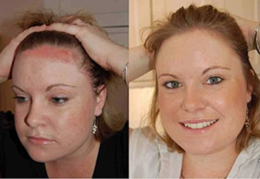
Psoriasis is a chronic, non-contagious autoimmune disease that affects the skin and joints. It commonly causes red, scaly patches to appear on the skin. The scaly patches caused by psoriasis, called psoriatic plaques, are areas of inflammation and excessive skin production. Skin rapidly accumulates at these sites and takes on a silvery-white appearance.
The cause of psoriasis is not known, but it is believed to have a genetic component. Factors that may aggravate psoriasis include stress, withdrawal of systemic corticosteroid, excessive alcohol consumption, and smoking.
Types
The symptoms of psoriasis can manifest in a variety of forms.
(a) Plaque psoriasis (psoriasis vulgaris) (L40.0) is the most common form of psoriasis. It affects 80 to 90% of people with psoriasis. Plaque psoriasis typically appears as raised areas of inflamed skin covered with silvery white scaly skin. These areas are called plaques.

(b) Flexural psoriasis (inverse psoriasis) (L40.83-4) appears as smooth inflamed patches of skin. It occurs in skin folds, particularly around the genitals (between the thigh and groin), the armpits, under an overweight stomach (pannus), and under the breasts (inframammary fold). It is aggravated by friction and sweat, and is vulnerable to fungal infections.
(c) Guttate psoriasis (L40.4) is characterized by numerous small round spots (differential diagnosis—pityriasis rosea—oval shape lesion). These numerous spots of psoriasis appear over large areas of the body, such as the trunk, limbs, and scalp. Guttate psoriasis is associated with streptococcal throat infection.
(d) Pustular psoriasis (L40.1-3, L40.82) appears as raised bumps that are filled with non-infectious pus (pustules). The skin under and surrounding the pustules is red and tender. Pustular psoriasis can be localised, commonly to the hands and feet (palmoplantar pustulosis), or generalised with widespread patches occurring randomly on any part of the body.
(e) Nail psoriasis produces a variety of changes in the appearance of finger and toe nails. These changes include discolouring under the nail plate, pitting of the nails, lines going across the nails, thickening of the skin under the nail, and the loosening (onycholysis) and crumbling of the nail.
(f) Erythrodermic psoriasis involves the widespread inflammation and exfoliation of the skin over most of the body surface. It may be accompanied by severe itching, swelling and pain. It is often the result of an exacerbation of unstable plaque psoriasis, particularly following the abrupt withdrawal of systemic treatment. This form of psoriasis can be fatal, as the extreme inflammation and exfoliation disrupt the body's ability to regulate temperature and for the skin to perform barrier functions.
Diagnosis
There are no special blood tests or diagnostic procedures for psoriasis. Sometimes a skin biopsy, or scraping, may be needed to rule out other disorders and to confirm the diagnosis. Another sign of psoriasis is that when the plaques
Treatment
Psoriasis is not an external but an internal, arising out of faulty immune system with genetic predispositions. Needless to say the disease is deep seated and calls for well planned deeply acting medicines. Conventional treatment with steroid can suppress (what they call ‘manage’) the symptoms of the disease but cannot cure the disease.
Homeopathic treatment:
Homeopathy stimulates body’s own healing process. It works at root level and restores deviated immunity back to normalcy, by addressing the genetic tendencies .Homeopathy uses natural medicinal substances in ultra-minute quantity rendering a treatment that is extremely effective yet absolutely free from any side-effects whatsoever.
Psoriasis is an obstinate and chronic disease. There is no shortcut to its cure.
The length of treatment varies form case to case, depending of the factors: as
Duration of Psoriasis,Areas affected,Extent of spread,Previous medication (Extensive use o oral cortisone may delay the course of treatment)
It is very clear from the above discussion that psoriasis is not so simple to prescribe for. So, it requires a lot of detailed study of the patient before anything can be prescribed. It requires a deep constitutional analysis.The history of the disease, the family medical history, physical and mental characteristics of the patient, the likes and dislikes, medication details are all taken into consideration. This approach stands in consonance with the homoeopathic convention: ?Treat the patient, not the disease?.